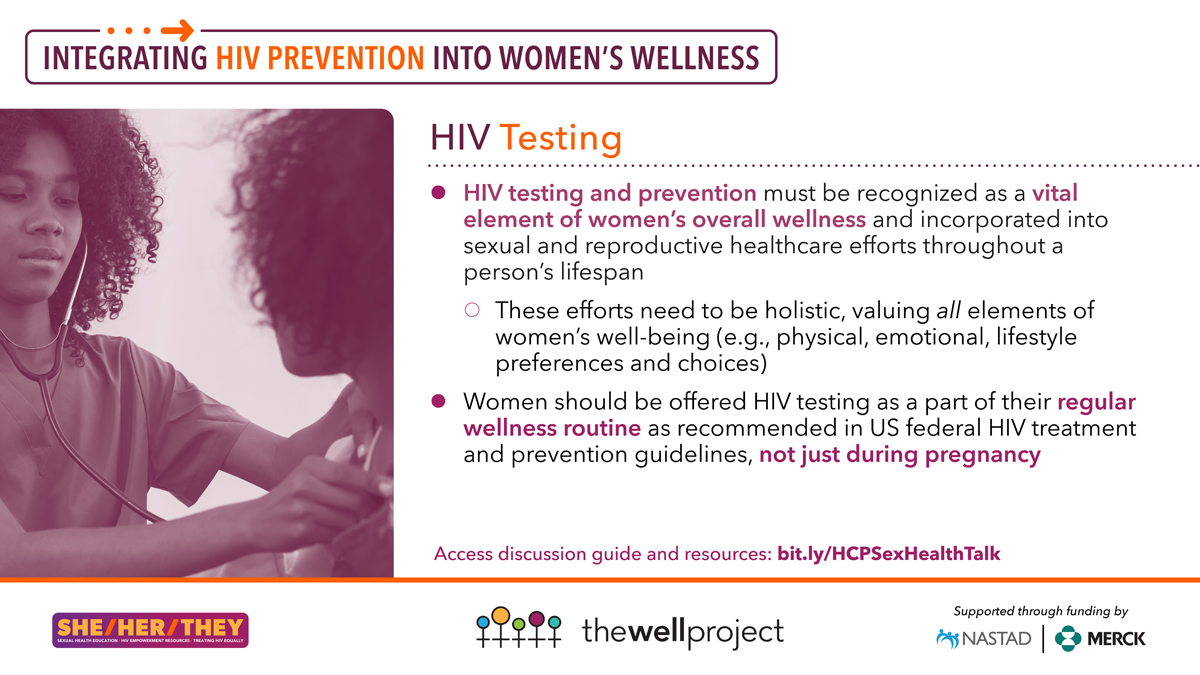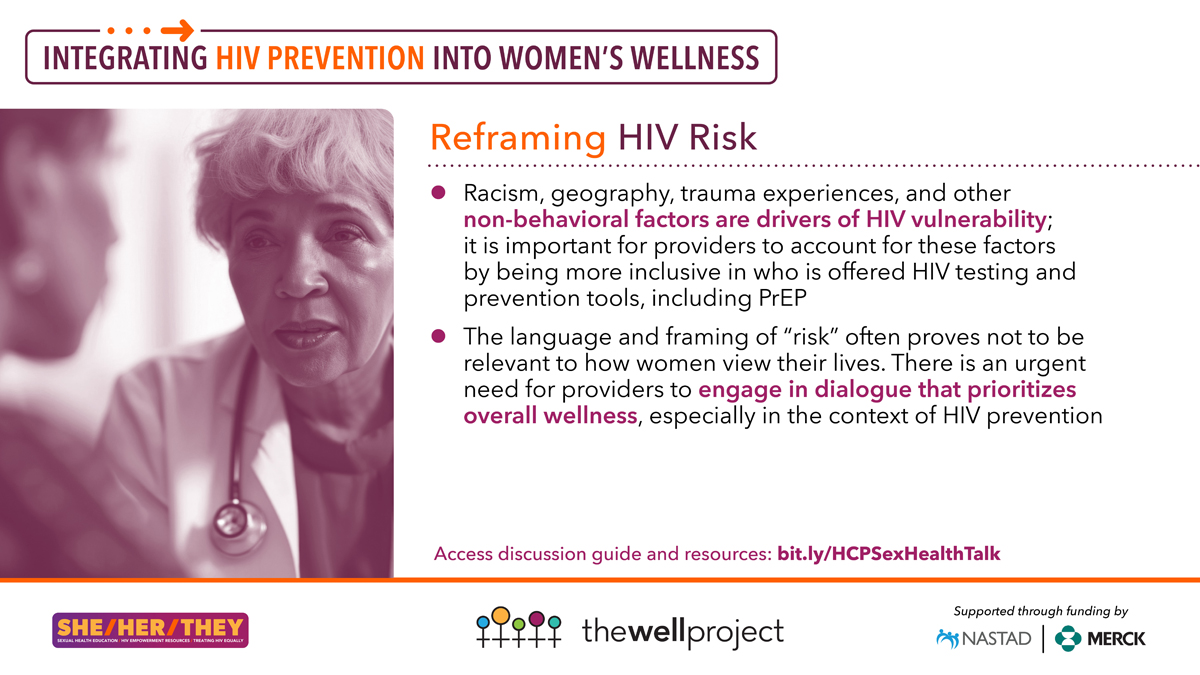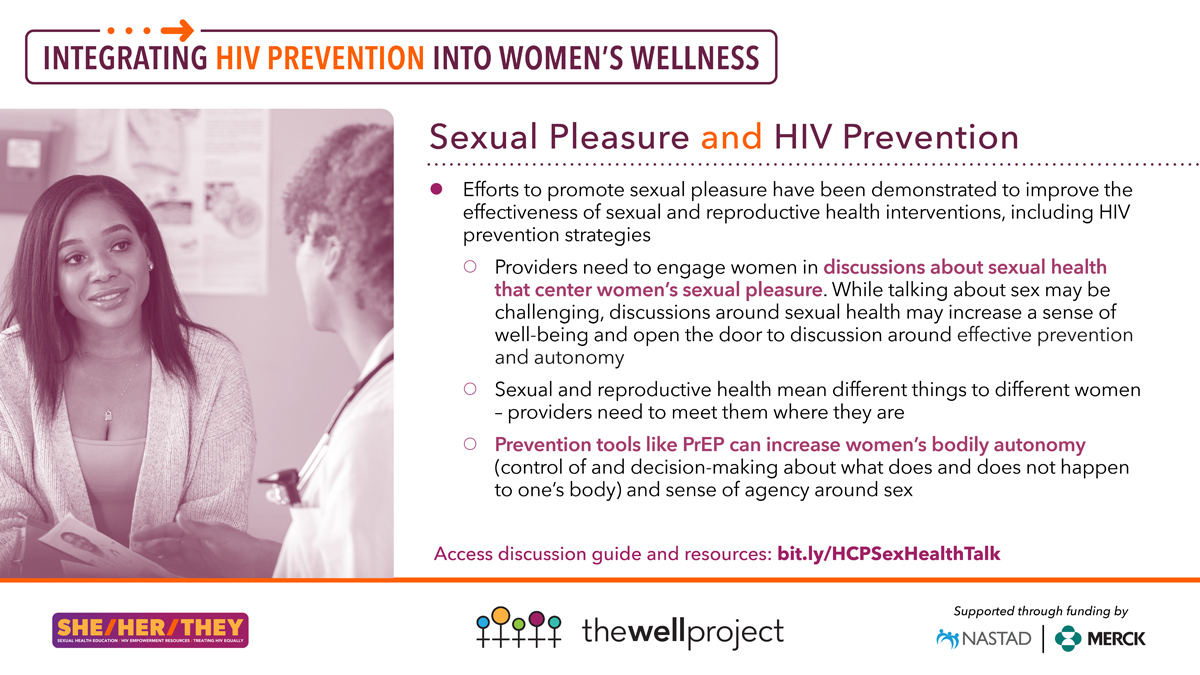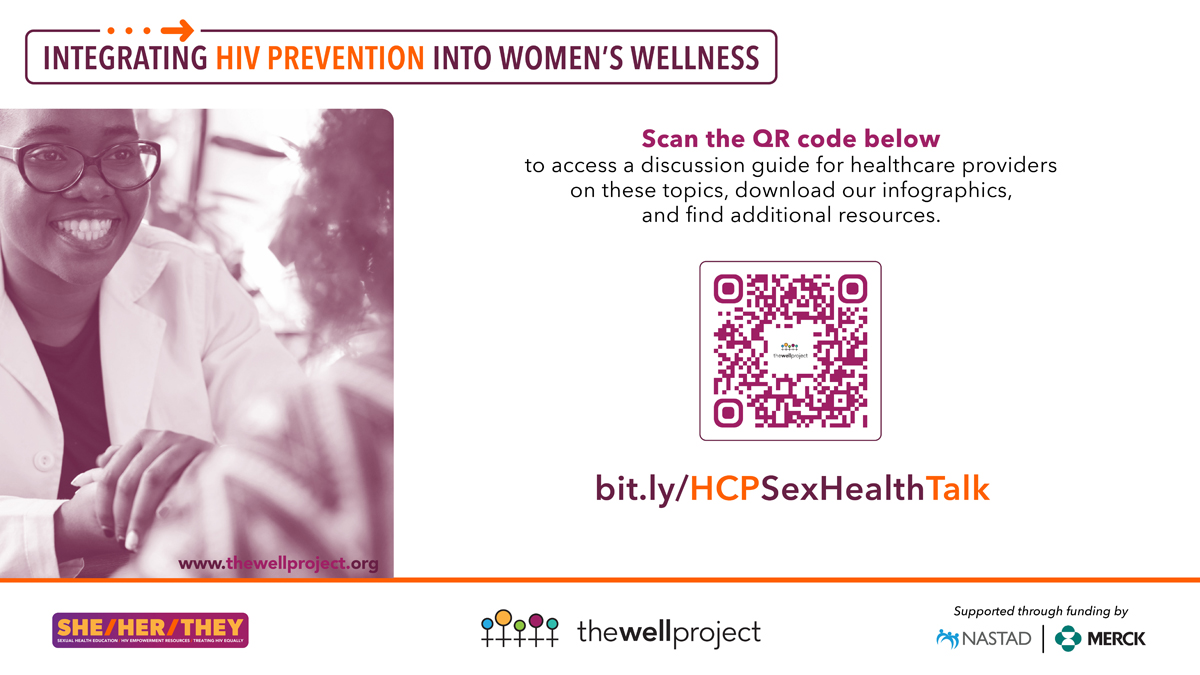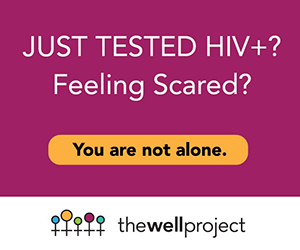
Table of Contents
- Discussing Sex and Sexuality
- Starting the Conversation
- Infographics: Integrating HIV Prevention into Women's Wellness
- Additional Resources from The Well Project
- References
The ability to have pleasurable, safe sexual experiences if one chooses to has been identified as a central aspect of health and wellbeing by the World Health Organization and other institutions worldwide. To make this assertion a reality, healthcare providers must be equipped to discuss pleasure and HIV prevention with women as part of their sexual and reproductive healthcare, and their overall wellness.
Through meaningful dialogue rooted in shared decision-making and respect, providers can normalize HIV and integrate prevention into efforts to support women's overall health – including their sexual health, pleasure, and bodily autonomy. Below is a series of considerations, talking points, and shareable infographics to help inspire and guide these crucial conversations.
This resource is part of SHE/HER/THEY (Sexual Health Education/HIV Empowerment Resources/Treating HIV Equally), The Well Project's educational outreach initiative focused on improving engagement in care, health outcomes, and well-being for women living with and vulnerable to HIV while promoting language justice and holistic wellness through a non-stigmatizing lens.
Discussing Sex and Sexuality
When discussing sex and sexuality with patients:
- Be mindful of personal bias: How comfortable do you feel talking about sex in general or discussing sexual health outside of STI testing?
- Recognize that bias may appear in judgments about a woman's sexual expression, sexual identity, and her choices about sexual or reproductive health
- Think outside the "five P's" (Partners, Practices, Past History of STIs, Protection from STIs, and Pregnancy Intention) to include Pleasure
- Taking a detailed sexual history in a thoughtful, trauma-informed manner can be a crucial component of trust-building
- Trauma-informed care should support self-advocacy
- Meet women where they are, while leaving room to expand the conversation
- Recognize that women may have sex related to survival, housing, or money, and it may involve drug use. These conversations should focus on harm reduction and not on judgement.
It is important to use an approach that:
- Leverages open-ended questions without assigning guilt and shame and without making assumptions about the ways people have sex or with whom they have sex
- Encourages dialogue, neutrality, and mutuality
- Mutuality is characterized by empathy, collaboration, and equality (i.e., acceptance of differences)
- Uses people-first language
Starting the Conversation
Below is a list of sample questions to help guide conversations with your patients about sexual health, wellness, and HIV prevention, including PrEP (pre-exposure prophylaxis). These questions are designed to normalize HIV within women's healthcare.
| Current Sexual Experience |
|
| HIV Testing |
|
| HIV Prevention and PrEP |
|
Download a PDF of the talking points
Infographics: Integrating HIV Prevention into Women's Wellness
Save and share the individual images below in jpeg or pdf format, or download a pdf featuring the entire series of infographics.
Overview
Click the image above to save as a jpeg or share online; or download a printable pdf of "Overview: Integrating HIV Prevention into Women's Wellness"
HIV Testing
Click the image above to save as a jpeg or share online; or download a printable pdf of "HIV Testing: Integrating HIV Prevention into Women's Wellness"
Reframing HIV Risk
Click the image above to save as a jpeg or share online; or download a printable pdf of "Reframing HIV Risk: Integrating HIV Prevention into Women's Wellness"
Normalizing HIV Testing and Prevention
Click the image above to save as a jpeg or share online; or download a printable pdf of "Normalizing HIV Testing and Prevention: Integrating HIV Prevention into Women's Wellness"
Sexual Pleasure and HIV Prevention
Click the image above to save as a jpeg or share online; or download a printable pdf of "Sexual Pleasure and HIV Prevention: Integrating HIV Prevention into Women's Wellness"
Share These Resources
Click the image above to save as a jpeg or share online; or download a printable pdf of "Share These Resources: Integrating HIV Prevention into Women's Wellness"
The development of the above tools was supported by NASTAD and a grant from Merck for SHE/HER/THEY.
The Well Project wishes to extend special acknowledgement to Carmen Logie, PhD (University of Toronto); Tonia Poteat, PhD, MPH, PA-C (Duke University); and Andrea Weddle, MSW (HIV Medicine Association), for expert consultation throughout the development of this resource.
Additional Resources from The Well Project
Program Materials
SHE/HER/THEY (Sexual Health Education/HIV Empowerment Resources/Treating HIV Equally
Black Women Living with and Vulnerable to HIV in the US: Leadership Exchange LIVE
Sex, Pleasure, and PrEP: Leadership Exchange LIVE
Fact Sheets
Sexual and Reproductive Health, Rights, Justice, Pleasure, and HIV
Gynecologic Care and HIV: What to Expect and Preparing for Appointments
References
HIV Prevention Guidelines (HIVinfo)
Opening a Portal to Pleasure Based Sexual and Reproductive Health Around the Globe; A Qualitative Analysis and Best Practice Development Study (Sexual and Reproductive Health Matters)
GOALS Framework for Sexual History Taking in Primary Care (New York State Dept of Health AIDS Institute)
No Longer the Exception, but the Standard: Integrating Trauma-Informed Policy and Pre-exposure Prophylaxis Implementation for Women (Women's Health Issues)
Providing Primary Care for HIV in the Context of Trauma: Experiences of the Health Care Team (Women's Health Issues)



